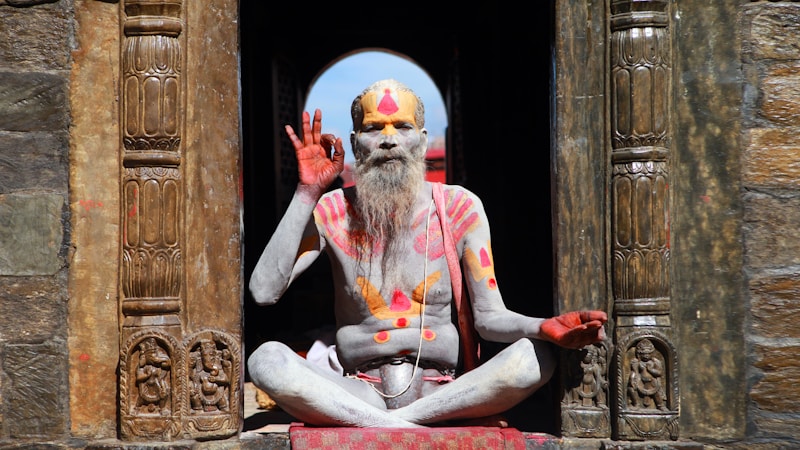Sex, food, yoga – are these things we should only have in moderation? In a world of sensory overload, it’s easy to get confused between what we need, and what we want, but how would you react if we told you that sex, food and even yoga should all be taken in moderation?
Say What?
Brahmacarya is our fourth yama, and the cause of huge controversy back in 2013 when Canadian brand Lululemon printed the word across the front of one of its tote bags. How so? Brahmacarya is often translated as celibacy, which certain influential publications thought was an unusual word to splash across what is essentially a fashion accessory. There’s much, much more to this enigmatic yama than a 21st century branding scandal though — let’s look a little deeper.
Brahmacarya might be translated as celibacy, but that’s a little too simplistic (maybe even dogmatic) to my mind. Literally translated, brahman means God, and in this context carya means move with, or remain with. You can be excused from not immediately getting the link from ‘to move with God’ to ‘celibacy’, but this is where it’s worth reminding ourselves of the tradition in which the yamas and niyamas are rooted.
The Yoga Sutras, where the yamas and niyamas first appeared, were written around 200 – 400 CE in a time when yoga was practised and taught almost exclusively by men. Celibacy as part of your yoga practice (or fidelity to your wife if you happened to be married) was thought to be a way of keeping the batteries charged, building up willpower and preserving prana, your life force. ‘Storing’ semen in the body was thought to be the equivalent of a savings account. Rather than splurge your savings on the latest fashion (like a Lululemon tote bag), you should build up the savings to accumulate into something far, far greater: enlightenment, anybody?
Fast forward to 2015, it would be somewhat awkward if all of a sudden we started telling people to lay off the sex. Firstly I don’t think we’d make ourselves very popular, and secondly it just doesn’t seem quite right to just write off something which can be beautiful. Plus, considering that the majority of yoga practitioners don’t actually have semen (over 85% of yoga practitioners are female according to this report from 2012), this traditional translation starts to feel a little out dated. So let’s look at brahmacarya in another way – as moderation in our actions.
Using Brahmacarya On The Mat
Practising moderation in our actions on our mats is much like practising some of the other yamas we’ve already discussed. We want to be kind to ourselves (ahimsa) and practise with truthfulness (satya). We want our āsana to give us energy and build the prana, not to deplete it. For a lot of us, we want to maintain a regular practice, and if we practise beyond ‘our edge’, if we make ourselves breathless, exhausted or wired through āsana, we’re not really being truthful, kind or moderate.
At first this might sound weird. Surely we should push ourselves to get results? Yes, we do need to challenge ourselves in our āsana practise, but if you’re in this for the long haul it won’t take long before you realise that āsana is about more than just your physical body. The more sensitive you become as a result of your yoga practise, the more you can begin to tune into the subtleties of your energetic body. Understanding these different components of āsana practise will help you to choose a sequence which will wake you up, calm you down, ground you or whatever you need in that moment.
You can begin by bringing your awareness back to the breath throughout your yoga class. Whenever your mind starts wandering off, bring it back to the simple act of observing the breath. This is one of the best ways to notice what’s happening energetically for you.
Moving Brahmacarya Off The Mat
Where can we apply brahmacarya in our lives? One of the most common ways we’re taught to practise moderation nowadays is in our eating habits. Gluten-free, paleo, vegan, wheat intolerant, eating six small meals a day, fasting every 6 weeks… when did food get so complex? Sivananda, a prominent Yoga teacher of the 20th century had a pretty sensible approach to life in his teachings. His five points of yoga listed proper rest, proper exercise, proper breathing, and positive thinking alongside proper diet as the main principles to follow as part of physical, mental and spiritual well-being.
Whilst the details of what a proper diet consists of will be unique to each of us, there are things we can do to help us understand our eating habits a little better. For example you could keep a food diary or note any emotional or situational connections with food — like reaching for the biscuit tin when that deadline is fast approaching. Beginning to learn the difference between hunger and thirst is another useful way to bring your appetite under control, and chewing your food properly before going back for seconds are two more practical ways you can control your appetite, or as Patañjali might say, moderate your senses.
You may still be wondering where does sex fit into all of this? My answer is that there isn’t a straight answer. As is so often the case in yoga, it’s about listening to your heart, your inner teacher, and choosing a path that feels right for you. Whether that’s sticking with one partner for life, or (as a bisexual friend of mine so eloquently put it) maybe walking on both sides of the street for a while. The important part is to make a choice that makes you feel good. After all, one thing I can be sure of – yoga ain’t suppose to make you feel bad!
Taking Brahmacarya From Here
In a world of sensory overload, it’s easy to get confused between what we need, and what we want. One reason a regular āsana practise can do us so much good is that that we can enjoy all of our senses. We can then feel satisfied with less as we fully immerse into the present experience – be that eating that slice of cake, making love with our partner or even just the simple act of moving our body on the yoga mat.
What do you think about this controversial yama? Do you believe in approaching life moderately to do you think we should all just go for it hell for leather? Can you challenge yourself for one day to really notice each bite of food that you take, and notice the effect it has on your appetite, and in turn, your energy levels? Give it a try!












